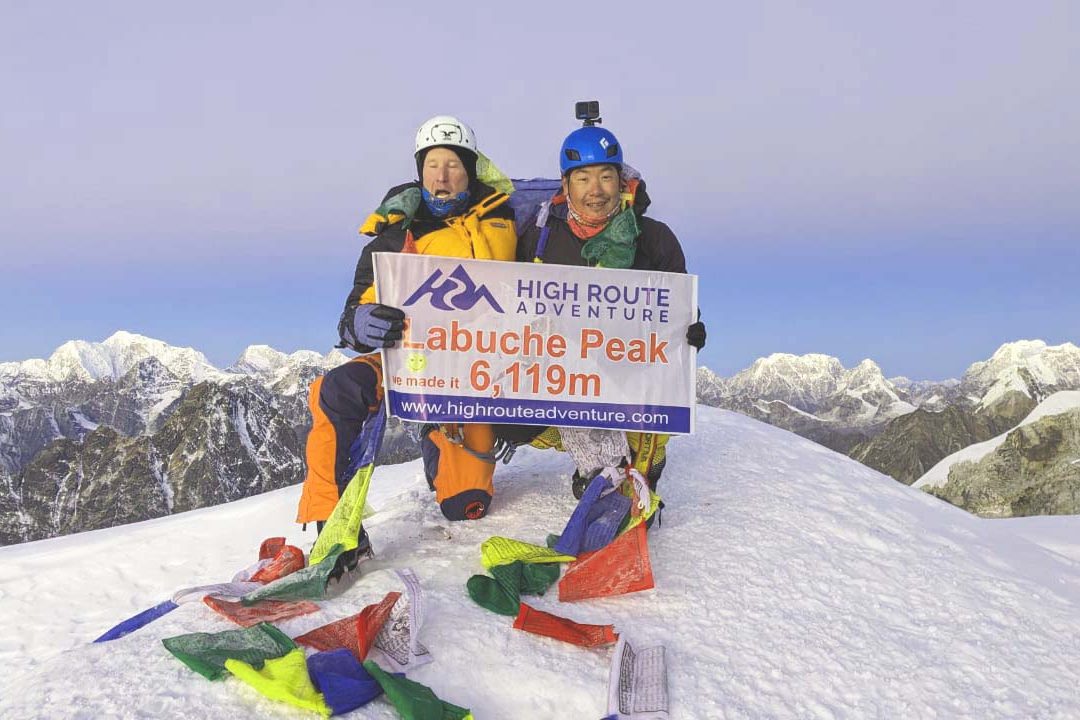How Difficult is Lobuche Peak Climbing?

Nepal, the motherland of Himalayas, has a lot to offer in terms of adventure and nature’s alluring beauty. Peak Climbing is one such which comes with challenges however rewards you with mesmerizing vistas.
Among the many others, reaching the summit of Lobuche Peak is a dream to numerous adventure lovers worldwide. Though the journey is full of adventure, Lobuche Peak Climbing is demanding for beginners.
The Lobuche Peak Climbing difficulty is distinguished by various factors including altitude, duration, route, accommodation, and more. Keeping that in mind, one must prepare being cautious about the risk involved. Nevertheless, it is tough but not impossible.
The insights discussed below covers almost all the crucial factors that characterize the difficulty of Lobuche Peak Climbing. Not just the factors involved, the guide to preparing for the summit attempt is mentioned properly.
For booking package click here: Lobuche Peak ClimbingTable of Contents
Understanding Lobuche Peak
Situated in the Khumbu region of Nepal near Mount Everest, Lobuche Peak stands tall at 6,119 meters. The journey to the summit requires basic technical climbing skills to ascend.
Most routes follow the challenging Southeast Ridge route which involves steep snowy traverses and rocky scrambles.
Weather conditions are highly variable and afternoon storms are common during the main climbing seasons of spring and autumn. Reaching the top requires immense mental stamina and physical conditioning.
While extremely rewarding for successful climbers, Lobuche Peak should not be underestimated and demands thorough preparation.
Major Attractions of Lobuche Peak Climbing
- Located in the Khumbu region near Mount Everest at an elevation of 6,119 m
- Requires basic technical climbing skills
- Involves steep snow climbs, rocky trails, and traversing high altitudes
- Overlooks the massive Khumbu Glacier below
- Highly variable weather with potential afternoon storms
- Opportunity to witness incredible Himalayan scenery and landscapes
- Trekking through traditional Sherpa villages and tea houses on the approach
- Chance to acclimatize and train on smaller peaks first
- Testing your physical endurance and mental stamina at altitude
- Accessible from Lukla with a scenic flight into the Khumbu region
Is Lobuche Peak Climbing Difficult?
Lobuche Peak presents numerous climbing challenges that make it difficult for even experienced mountaineers. The rigorous steep snowy slopes, rock scrambles, extreme weather conditions, and high altitude all combine to create a demanding Himalayan ascent.
However, if you come prepared with proper training, gear, guidance, pacing, and determination, the mighty Lobuche summit can be attained definitely.
Factors Affecting Lobuche Peak Climbing Difficulty
Though climbing Lobuche Peak is not as strenuous as summiting expeditions above 7,000m-8,000m mountains. However, reaching the Lobuche Peak’s summit is challenging requiring prior high-altitude trekking experience.
Expect various factors such as altitude, route, duration, etc. to become hurdles that need to be surpassed along the journey. Let’s discuss the factors impacting the difficulty of Lobuche Peak Climbing in detail.
Route to Lobuche
The journey to Lobuche Peak, though only moderately difficult, presents challenges for even experienced climbers. One must be prepared to walk 5-6 hours daily over rugged terrain, including steep uphills and downhills along unmarked trails.
Caution and technical skills is required. Parts of the route are quite harsh and can be daunting for beginners. Proper training, ample supplies, and navigation skills are critical. With preparation and determination, the rewarding Lobuche summit can be attained through step-by-step progress along the route.
Reaching the Summit of Lobuche Peak
Conquering the summit of Lobuche requires fitness, proper gear, and perseverance. The final ascent presents a 45 degree snowy, steep slope that can prove difficult for novices.
One must allot 7-10 hours on summit day to overcome this challenge and reach the top. Caution is advised, as the high elevation also brings the risk of altitude sickness.
However, with adequate training, equipment, pacing, and precautions, this formidable yet achievable Himalayan summit can be successfully gained. Step-by-step, utilizing caution and resolve, even beginners can experience the satisfaction of reaching Lobuche’s pinnacle.
Duration
The Lobuche Peak Climbing traverses approximately 20 days from start to finish. Though briefer than peak climbings like Island, proper timing and pacing is still essential.
The journey commences in Kathmandu with preparation and flight to Lukla. Trekking to Base Camp and acclimatization requires several days before attempting the 8 hour final summit ascent.
Adequate time is allotted for the climb itself as well as the return trek out from Lobuche. With strategic scheduling and efficient use of time, climbers can complete this relatively compact Himalayan climb from start to end in about three weeks.
Technical Section
Lobuche Peak possesses two summits i.e. Lobuche East and Lobuche West. The east is more accessible and the less challenging Lobuche Peak.
The standard Southeast Ridge route up Lobuche Peak gained renown when mountaineers Laurice Nielson and Ang Gyalzen Sherpa first successfully ascended this way on April 25, 1984.
This path presents a 50 meter high, 45 degree snow-covered wall that requires technical climbing skills and gear to overcome. The peak overlooks the scary Khumbu Glacier, adding further difficulty.
However, the unusual rock triangular shape extending from Lobuche’s summit to the glacier provides visible lateral moraines and stone memorials to guide climbers along the ridge.
Though not technically simple, the route is achievable for fit climbers with proper preparation. The sweeping Himalayan vistas awaiting at the top provide inspiration to persevere.
Step-by-step, utilizing caution and purpose, mountaineers can gain the summit of this peak along the celebrated Southeast Ridge first pioneered decades ago.
Weather Conditions
The unstable weather of the high Himalayas must be properly considered when planning a Lobuche Peak Climbing. Spring and Autumn offer the most stable conditions, with clear skies to showcase the majestic mountain landscapes.
Summer monsoon season brings heavy rainfall, fog, and slippery muddy trails that can impede progress. During the frigid winter, snowfall covers the already dangerous paths, requiring caution and specialized gear to traverse safely.
Regardless of season, temperatures fluctuate dramatically in the altitude extremes. Even warm months see freezing temperatures in the mornings and nights. As climbers ascend higher, the temperature drops further, necessitating proper insulating gear.
The average temperature range spans from -9°C in winter to 5°C in summer. However, the lower valleys tend to remain moderately warmer than the upper region. With strategic timing and packing, climbers can best cope with the mercurial weather.
Though always demanding respect, when handled properly, the elements will not discourage a determined mountaineer from reaching Lobuche’s summit.
Remoteness
The remote trails to Lobuche demand climbers be fully self-sufficient and adaptable. Tea houses offer the only lodging, providing shared twin rooms, communal dining, and basic sanitation.
Mattresses, linens, and blankets are supplied, but climbers must bring sleeping bags for hygiene. Bathrooms lack hot running water, instead offering heated buckets per request. Wifi and electricity are rare luxuries, so external batteries and data packages are essential.
Though rustic, these teahouses allow basic food and rest between rigorous trekking days. With few other resources available deep in the Khumbu, climbers must carry adequate gear, nutrition, and mental flexibility.
The utter remoteness also limits rescue options should emergencies arise. Through preparation, precaution, and self-reliance, climbers can embrace the isolation as part of the adventure.
Connection with nature and independence from modern trappings brings immense rewards. By immersing oneself in the solitary splendor of the Himalayas, the Lobuche summit takes on greater meaning.
Food
Food for the Lobuche climb is readily available along the route. Numerous tea houses provide hearty Nepali meals, local delicacies, and international cuisines.
These basic waypoints offer nourishing options to refuel between strenuous trekking days. Upon reaching Lobuche base camp, climbers switch to tent accommodations, relying on guide cooks to prepare meals.
Though light at high altitude, sufficient nutrition is accessible through the journey to maintain energy levels. With strategic planning and provisions, the remote trails need not mean deprivation.
Resourcefulness and preparation allow climbers to enjoy diverse, nourishing meals throughout their Himalayan journey.
Accommodation
Accommodation options are limited in the remote, high altitude environment of Lobuche Peak. As elevation increases, amenities decrease; beyond base camp only sparse tent camping is available.
During busy seasons, securing even low standard tea house rooms can require advanced booking and waitlists for shared facilities. Bathrooms and sleeping quarters offer little privacy.
Once above base camp, climbers must rely on their own tents and camp cooks. With preparation, these rustic conditions can be managed. Bring ample sleeping bag for frigid tent nights.
Schedule strategic rest stops to maximize tea house availability. Temper expectations for comfort and privacy. However, the summit views make the journey worthwhile.
Physical and Mental Stamina
Though previous climbing experience is not required for Lobuche Peak, related training is highly beneficial.
Physical conditioning through months of regular jogging and long-distance walking builds core strength and endurance for the demanding summit attempt.
During the journey, pre-climb training sessions provide instruction in utilizing ropes, ice axes, crampons, and other gear critical for the final ascent.
Mental stamina is equally vital to withstand the grueling 8-10 hour push to the top. Willpower and positivity must override any impulses to quit.
Those with severe respiratory or chronic illnesses should consult medical professionals before attempting the climb, as supplemental oxygen is unavailable at high altitudes.
With dedication through preparatory training, both the body and mind can be primed to withstand the challenges of summit day and fully enjoy the rewards of gazing out from Lobuche’s peak.
How Do I Prepare for the Lobuche Peak Climbing?
The keypoints mentioned below is a must for preparing the climb to Lobuche Peak in the right way:
- Get in shape – Train for months by hiking long distances with a loaded backpack to build endurance and leg strength. Also incorporate strength training.
- Gain technical skills – Take a mountaineering course to learn essential skills like self-arrest with an ice axe, climbing on fixed lines, and using crampons. Familiarize yourself with climbing gear.
- Acclimatize – Take time to acclimatize to the high altitude by trekking in the Khumbu region and climbing smaller peaks first. Prevent altitude sickness.
- Research the route – Study the Southeast Ridge route so you know what to expect. Understand the most challenging parts like the 45 degree snow wall near the summit.
- Assemble gear – Gather all necessary technical mountaineering gear, layers, and supplies. Don’t forget critical items like sunglasses, headlamp, and first aid kit.
- Hire experienced guides – Choose reputable guides familiar with Lobuche Peak. Listen and learn from their expertise.
- Manage expectations – Understand that summiting Lobuche is difficult for even experienced climbers. Focus on safety over reaching the top.
- Develop mental determination – Prepare to withstand extreme cold, fatigue, and basic conditions. Stay positive and determined during the climb.
- Allow extra time – Schedule a few extra days for weather delays, acclimatization, or recovering strength between difficult trekking days.
Must-Know Tips for Climbing Lobuche Peak
Here are must-know tips for climbing Lobuche Peak:
- Acclimatize fully before the summit attempt to prevent altitude sickness. Take it slow and listen to your body.
- Bring proper layered clothing and gear to withstand the extreme cold and wind at high elevations.
- Start summit day very early (midnight or 1am) to reach the top and descend before afternoon storms roll in.
- Follow the experienced guide’s pace and instructions closely. Don’t split off on your own.
- Take scheduled breaks to rest, hydrate, refuel, and assess your energy level. Turn around if not feeling well.
- Use the proper technique for each climbing challenge like a fixed line, rocky scramble, or steep snow.
- Keep an eye out for changing mountain conditions and hazards like rockfall, avalanche dangers, etc.
- Maintain focus and determination during the long, grueling summit day. Draw on your mental preparation.
- Have a backup plan and know when to turn around if the weather takes a bad turn or you’re too exhausted to proceed safely.
- Take care descending and follow the same route you ascended. This is when most accidents happen due to fatigue.
Final Thoughts
Though challenging, Lobuche Peak presents a worthy challenge for driven climbers. With necessary preparation, realistic expectations, and step-by-step perseverance, this Himalayan giant can be summited.
The sense of accomplishment and breathtaking vistas from the top make every ounce of effort worthwhile. For those seeking to test their limits, climbing Lobuche leaves no regrets.
Posted on








